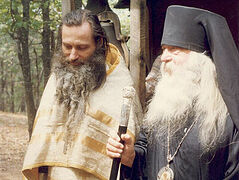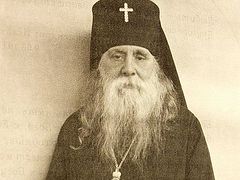This article by Archimandrite Damjan (Cvetkovic) examines the influence of the Russian emigration, in particular Russian monasticism (both male and female), on Serbian monasticism. Owing to Russian priests, theologians, monastics, and ordinary believers who came to Serbia after the revolution, the Serbian Church witnessed a spiritual revival, its groundwork already laid out by the religious movement headed by the Holy Hierarch Nikolai (Velimirović). Among the great number of those who contributed to the revival of the monastic tradition that had literally been abandoned in Serbia under Ottoman rule were Schema-Archimandrite Amvrosy (Kurganov) and Abbess Ekaterina (Efimovskaya), who labored in the monasteries of Miljkov, Kuvezdin and Hopovo.
The situation in Serbia following the First World War
The First World War had disastrous consequences for Serbia. During the war (1914-1918), Serbia lost almost a third of its total population, including about sixty percent of its male population. It was a time when any kind of growth was out of the question: The people simply had to survive. It hit the monastics the hardest.
In 1914, Serbia counted fifty-four monasteries housing ninety-three monks; female monasticism had almost completely disappeared
The information regarding the situation at the Studenica monastery eloquently testifies to this time of struggle just to survive. In the first years after liberation, Studenica Monastery, the “mother of Serbian monasteries,” had neither furniture nor firewood. The cause of their plight was not only the recently ended war, which led to a decline in the number of monastics, but also the Serbian Orthodox Church’s lack of mechanisms for supporting the economic sustainability of the monastic community in the face of harsh agrarian reforms that threatened a large number of ancient monasteries. Historical circumstances, causing psychological instability in a situation that required making critical life choices, contributed to the fact that the number of monks and nuns decreased and the monasteries in Serbia stood half-empty. According to the data from 1914, there were fifty-four monasteries in the Kingdom of Serbia housing ninety-three monks; female monasticism had almost completely disappeared.
However, thanks to the theological and missionary activity of the Holy Hierarch Nikolai (Velimirović), the soil of the soul of the Serbian people was prepared to receive the seed of Russian monasticism, which eventually bore great fruit.
The arrival of Russian emigrants to Serbia
Our conscience makes us cry when the Russians cry and rejoice when the Russians rejoice. We are greatly indebted to Russia. A man can be indebted to a man, and a people can be indebted to a people. But the debt with which Russia obliged the Serbian people in 1914 is so huge that neither centuries nor generations can repay it. It’s a debt of love, which goes blindfolded to meet death while saving a neighbor. There’s no greater love than to lay down one’s life for his friends—these are the words of Christ. The Russian Tsar and the Russian people, unprepared to enter the war in defense of Serbia, couldn’t but know that they were going to their deaths. But the love of the Russians for their brothers didn’t retreat in the face of danger and wasn’t afraid of death. Blessed are you who weep today together with Russia, because you will be comforted together with it! Blessed are you who mourn today with Russia, because you will soon rejoice with it.
With these words of his preaching, St. Nikolai (Velimirović) best expressed the feelings of the Serbian people toward Russia and the sacrifice of the holy Tsar Nicholas II.
This feeling of gratitude wasn’t simply in the heart, but actively present, and was made manifest especially when the time came to offer shelter to Russian exiles. Therefore, after the First World War, Russian Orthodox emigrants (believers and clergymen) formed one of the centers of Russian church life on the canonical territory of the Serbian Orthodox Church. The Russian emigration (clergy, theologians, and believers) brought their own particular piety, sanctified and confirmed over the centuries, to the Orthodox Serbs. The one-of-a-kind “Russian soul” was interwoven into the life of the united and renewed Serbian Church in the twentieth century, and the friendly Serbian-Russian Church ties, which began in the thirteenth century, grew even stronger.
Contribution of the Russian emigration to Serbian life and culture
As a result of the October Revolution, the victory of the Bolsheviks, and the ensuing civil war, streams of Russian emigrants and monarchist refugees poured out of Russia primarily to the kindred Slavic countries. The first refugees appeared in Serbia at the end of 1919. It’s estimated that a total of 50,000 refugees found their new home in the Kingdom of the Serbs, Croats and Slovenes. In 1920, a special state commission was formed to deal with refugee problems, ensuring they received social protection, emigrant status, accommodation, etc.
In February 1921, Metropolitan Anthony (Khrapovitsky) arrived in Serbia. Immediately after his arrival, the Council of Bishops of the Serbian Orthodox Church decided to take the Supreme Ecclesiastical Administration of the Russian Orthodox Church under its protection, and in November 1921, the Russian Orthodox Church Abroad was formed. The Russian Orthodox Church Abroad enjoyed the moral, financial, and diplomatic support of the Serbian Orthodox Church in the interwar period.
As a result of the emigration of Russian refugees, Serbia received serious scientific and cultural support
Since the Russian emigration was made up of the most educated part of the Russian society, Serbia received considerable scientific and cultural support. At the time, fifty percent of the Serbian population aged twelve and older was illiterate, while the number of illiterates among the Russian refugees was only three percent. Russian emigrants made up a fourth of the professors at the Belgrade University, and in some departments, like agriculture and medicine, they amounted to fifty percent of the teaching staff. As part of the medical department, they founded the Clinic of Internal Medicine. Twelve Russian scientists became academicians of the Serbian Academy of Sciences. Among them, I would like to mention philology professor George Ostrogorsky, one of the greatest Byzantine scholars of the twentieth century and recipient of many Russian and foreign academic awards.
With the help of Russian artists (worthy of mention among them are ballet dancer Nina Kirsanova and set dresser Vladimir Zedrinsky), the Belgrade National Theater was able to restore its ballet and opera productions.
Russian architects erected a great number of public buildings preserved to this day. Among them are the main post office building on Takovska Street in Belgrade, the Serbian government building, the Ministry of Foreign Affairs, and the old General Staff, a project of the White Palace, the building of the Serbian Orthodox Patriarchate, St. Alexander Nevsky Church, the Russian House, and the Holy Trinity Church built primarily with donations from Serbian officials. Nikola Pašić, the Serbian and Yugoslav politician and diplomat, donated 40,000 dinars (a considerable sum for that time) for the construction of the church. In 1929, the remains of General Wrangel, who asked to be buried “on a parcel of the Russian soil,” were moved to the Holy Trinity Church in Tašmajdan.
In the area of Church life and mission, that is, the work of Orthodox clergy and monastics in Serbian lands, the “Russian emigration factor” played a significant role. Many Russian emigrants, including Orthodox clergy, were often more educated than their local brethren.
Serbian help to their Orthodox kin
The first wave of Russian refugee monks heading to Serbia and the Serbian Orthodox Church is known about from a letter (April 1923) from representatives of the Athonite courts in Constantinople, who learned from their people from Odessa and Petrograd that 185 monks of St. Panteleimon’s Monastery and the St. Elijah and St. Andrew Sketes were expelled from the country by members of the “Living Church” (or the “spiritual Chekhists”) and asked Serbian Patriarch Dimitrije to take them in.
The hierarchy of the Serbian Orthodox Church hoped that Russian monks, as the embodied archetype of Eastern Orthodox asceticism, would revive Serbian monasticism by improving the quality of spiritual life.
However, it stirred up envy among the Serbian monks toward their Russian brethren. Some Serbian priests began to speak out against the participation of Russian refugee priests, who knew Liturgy and Church Slavonic, in the services, suggesting that Russians should instead be sent exclusively to serve in urban areas under the pretext they didn’t know the specifics of patriarchal rural life.
But there were others among Serbian priests who, on the contrary, defended their refugee brethren from Russia, noting the quality of their pastoral work, tactfulness, and successful leadership of the rational flock. The annals of one village church of the Diocese of Timok has preserved the following record from its priest:
A Russian brother came to the parish where I was serving. He repaired a rundown church. Attendance at the church and participation in the Liturgy and Communion by both men and women became more frequent... the priest is well-loved by the parishioners.
Thanks to the refugee monks, the Serbian Orthodox Church saw an increase in the number of those who chose an ascetic lifestyle
The most important thing attributable to the refugee monks was a significant increase in the number of people in the Serbian Orthodox Church who chose an ascetic lifestyle. The two best representatives of those who inspired hundreds of Serbs to monasticism and whose influence on monasticism can be felt to this day were Schema-Archimandrite Amvrosy (Kurganov) and Abbess Ekaterina (Efimovskaya).





